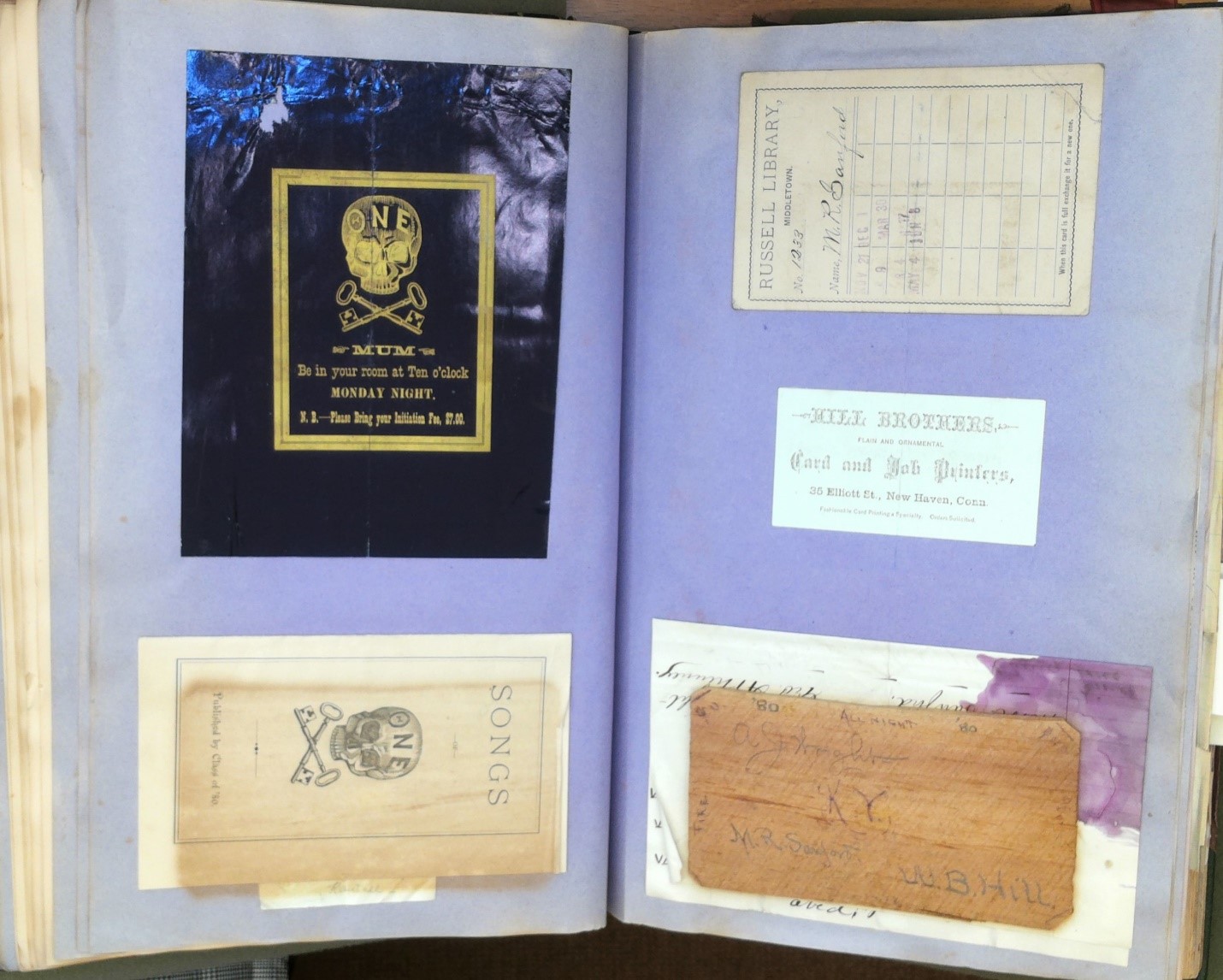Scrapbooks are repositories of ephemera, containers of memories, self-curated collections of the meaningful bits and pieces of a life. Creating scrapbooks was a popular pastime for American college students from the 1870s until World War I. These volumes can contain almost every type of material one can think of: business cards, dance cards, demerits, envelopes, exams, fabric scraps, flyers, fraternity or sorority paraphernalia, letters, library cards, locks of hair, matchbooks, notes, photographs, postcards, pressed leaves and flowers, programs, ribbons, tickets, wood scraps, and so much more. Lynn Smith Miller, Wesleyan Class of 1914, included a record of all the cigarettes he smoked, along with the remains of a pack of coveted Fatima Turkish cigarettes.
The two-volume scrapbook assembled by Myron Reed Sanford, Class of 1880, is a classic Wesleyan example. Blank albums were sold commercially, ready to be filled by their owners. Many styles became available, with fashions changing with the decades. Sanford’s album features papers of several different colors. By the early 1910s, some examples have Wesleyan red covers, a college logo, an expandable accordion structure, and pockets for loose items. The Wesleyan University Archives holds more than seventy-five scrapbooks created by individual students and others. Most are single volumes, but a few extend further. Karl Harrington, who graduated in 1882 and taught at Wesleyan for many years, left behind ten scrapbooks. Other volumes were the work of student organizations or University departments.
Like many Wesleyan students of his era, Myron Sanford carefully documented the ups and downs of his college activities, preserving both high-scoring exams and demerits for missing class or being unprepared. He saved posters, programs, and tickets from events he attended. Among the many intriguing items are flyers for a performance of the Hyer Sisters, African American pioneers of musical comedy; a demonstration of Edison’s phonograph or talking machine; and the strawberry and ice cream festival sponsored by the A.M.E. [i.e., African Methodist Episcopal] Church in Middletown, proceeds to help pay the pastor’s salary. Even though they were likely printed in large quantities, some of these survivors may well be unique. On the pages shown above, Sanford pasted documents related to his initiation into the sophomore class society Theta Nu Epsilon, also known as Skull and Keys; a nearly hidden note from his friend George Phinney; his Russell Library card; a business card for New Haven printers; a letter; and a mysterious scrap of wood that may relate to the initiation. After graduating from Wesleyan with special honors in Greek, Myron Sanford went on to a career as a classics professor, teaching at Haverford and Middlebury for nearly forty years. He died in 1939.
Scrapbooks are fascinating windows into the daily lives of their creators, often full of surprises and mysteries. Yet they pose special challenges for the archivists who preserve them. With layers of often unidentified documents, they can be tricky to catalog or digitize. The confluence of different materials can lead to acid migration and color transfer, such as that caused by the wood scrap in Sanford’s album above. Frequently the supporting paper onto which the scraps are glued does not age well and has become brittle with time. The adhesive itself often does not remain sticky, and scraps can easily fall out. Like the photograph albums that were so popular during the same period, some of the scrapbooks’ bindings are structurally unsound, especially when filled beyond intended capacity with the weight of many small treasures. Even so, scrapbooks are unparalleled for the insight they offer into lives of people long departed.
This blog post is eighth in a series on ephemera in Wesleyan’s Special Collections & Archives, presented in conjunction with the Center for the Humanities’ Spring 2021 theme of Ephemera. On April 19th at 6 p.m., Katie Pearl (Wesleyan) will lecture on “Entering a Life: María Irene Fornés and the Stuff of Making.” Here is the full series calendar.
– Suzy Taraba, Director of Special Collections & Archives


